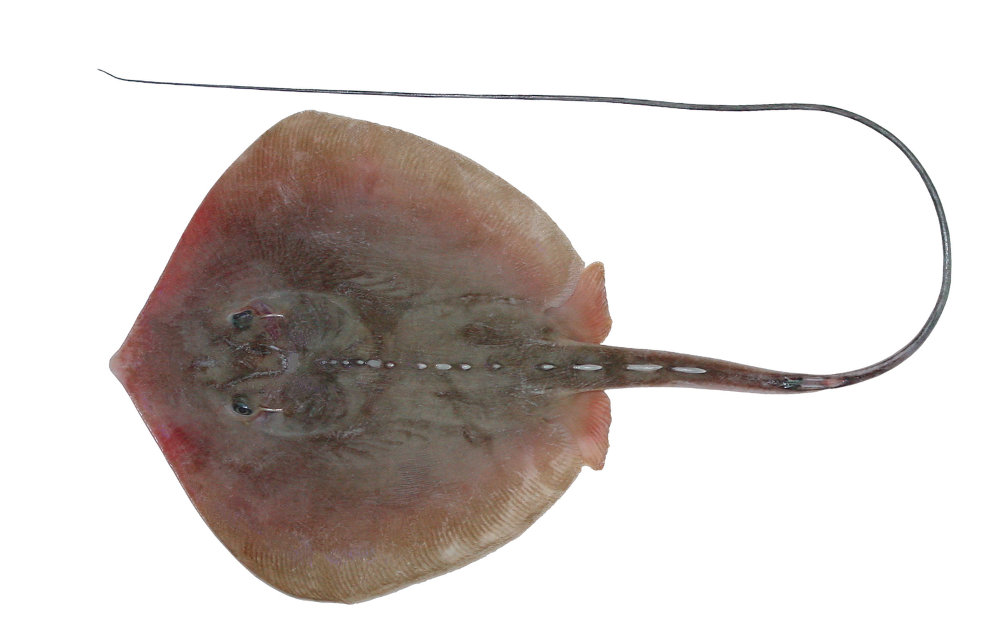Hemitrygon longicauda
(Last & White, 2013)
Merauke Stingray
Classification: Elasmobranchii Myliobatiformes Dasyatidae
Reference of the original description
Two new stingrays (Chondrichthyes: Dasyatidae) from the eastern Indonesian Archipelago. Zootaxa, 3722(1), 1–21
Two new stingrays (Chondrichthyes: Dasyatidae) from the eastern Indonesian Archipelago. Zootaxa, 3722(1), 1–21
Synonyms / new combinations and misspellings
Dasyatis longicauda
Dasyatis longicauda
Types
Hemitrygon longicauda
Dasyatis longicauda
Holotype: MZB: 21462; Paratype: CSIRO: H 5976-23; CSIRO: H 5976-24; CSIRO: H 5980-08; CSIRO: H 5980-09; CSIRO: H 5980-10; CSIRO: H 5980-11; CSIRO: H 5980-12; CSIRO: H 5980-13; CSIRO: H 5980-14; CSIRO: H 5980-15; CSIRO: H 5980-16; CSIRO: H 5980-17; CSIRO: H 5980-18; MZB: 15071; MZB: 15072;
Hemitrygon longicauda
Dasyatis longicauda
Holotype: MZB: 21462; Paratype: CSIRO: H 5976-23; CSIRO: H 5976-24; CSIRO: H 5980-08; CSIRO: H 5980-09; CSIRO: H 5980-10; CSIRO: H 5980-11; CSIRO: H 5980-12; CSIRO: H 5980-13; CSIRO: H 5980-14; CSIRO: H 5980-15; CSIRO: H 5980-16; CSIRO: H 5980-17; CSIRO: H 5980-18; MZB: 15071; MZB: 15072;
Description :
Citation: Hemitrygon longicauda (Last & White, 2013): In: Database of modern sharks, rays and chimaeras, www.shark-references.com, World Wide Web electronic publication, Version 12/2025
Please send your images of "Hemitrygon longicauda" to info@shark-references.com

Hemitrygon longicauda (Last & White, 2013) © Peter Last (CMAR, Hobart) and William White (CMAR, Hobart)

Hemitrygon longicauda (Last & White, 2013) © Peter Last (CMAR, Hobart) and William White (CMAR, Hobart)
Common names
Merauke Stingray
Merauke Stingray
Short Description
Description after LAST & WHITE, 2013 [19772]: A small species of Dasyatis with the following combination of characters: disc subcircular, width 1.0–1.1 times length; snout weakly triangular, angle 113–117°, length 1.7–2.1 times interorbital width; preoral length 2.1–2.3 times mouth width; internasal distance 1.7–2.0 in prenasal length; median body and pre-sting tail with a broken series of lanceolate to spear-shaped thorns extending posteriorly from nuchal region (162 mm DW); tail very elongate (2.3–2.9 times DW), filamentous to whip-like beyond sting, and sub-quadrangular in cross-section at mid-ventral skin fold, width 0.9–1.3 times its depth, postcloacal tail length 2.8–3.5 times precloacal length; ventral skin fold elongate, low, its length 1.8–2.4 in DW, height 0.3–0.4 in tail depth at its midlength; dorsal skin fold short or absent, when present low, barely taller than a ridge, much shorter than ventral fold; distance from cloaca to sting 1.5–1.7 in precloacal length; pectoral-fin radials 103–108; total vertebral centra (excluding 1st synarcuals) 114–120.
Description after LAST & WHITE, 2013 [19772]: A small species of Dasyatis with the following combination of characters: disc subcircular, width 1.0–1.1 times length; snout weakly triangular, angle 113–117°, length 1.7–2.1 times interorbital width; preoral length 2.1–2.3 times mouth width; internasal distance 1.7–2.0 in prenasal length; median body and pre-sting tail with a broken series of lanceolate to spear-shaped thorns extending posteriorly from nuchal region (162 mm DW); tail very elongate (2.3–2.9 times DW), filamentous to whip-like beyond sting, and sub-quadrangular in cross-section at mid-ventral skin fold, width 0.9–1.3 times its depth, postcloacal tail length 2.8–3.5 times precloacal length; ventral skin fold elongate, low, its length 1.8–2.4 in DW, height 0.3–0.4 in tail depth at its midlength; dorsal skin fold short or absent, when present low, barely taller than a ridge, much shorter than ventral fold; distance from cloaca to sting 1.5–1.7 in precloacal length; pectoral-fin radials 103–108; total vertebral centra (excluding 1st synarcuals) 114–120.
Distribution
only known near Merauke in West Papua, Indonesian Archipelago [19772]; Source: www.gbif.org
only known near Merauke in West Papua, Indonesian Archipelago [19772]; Source: www.gbif.org
Dentition
tooth rows count unclear, about 33 rows in upper jaw, about 38 rows in lower jaw; Teeth in upper jaw small, broadly lozenge-shaped, and similar in shape and size across jaw; without obvious cusps at this stage of development. Teeth in lower jaw smaller (about 2/3 width of those in upper jaw), acuspid. Teeth uniformly close-set in both jaws, arranged quincuncially [19772];
tooth rows count unclear, about 33 rows in upper jaw, about 38 rows in lower jaw; Teeth in upper jaw small, broadly lozenge-shaped, and similar in shape and size across jaw; without obvious cusps at this stage of development. Teeth in lower jaw smaller (about 2/3 width of those in upper jaw), acuspid. Teeth uniformly close-set in both jaws, arranged quincuncially [19772];
Remarks
shark-references Species-ID=14620;
shark-references Species-ID=14620;
















